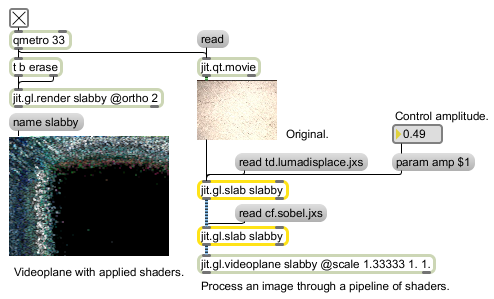Examples

Performs a GL accelerated grid-based evaluation
| (drag) | When an shader file is dragged from the Max 5 File Browser to a jit.gl.slab object, the file will be loaded. | |
| dispose | Disposes the currently loaded shader, passing the data through using the default multi-texturing behavior. | |
| dump | type [symbol] |
Dumps the indicated shader data to the max console window. Valid types are params, source, assembly. |
| getparamdefault | name [symbol] |
Sends the default data values for the indicated shader parameter for the internal jit.gl.shader object out the right-most outlet. |
| getparamlist | Sends the names of all the internal jit.gl.shader object shader parameters out the right-most outlet. | |
| getparamtype | name [symbol] |
Sends the name of the datatype for the indicated shader parameter for the internal jit.gl.shader object out the right-most outlet. |
| getparamval | name [symbol] |
Sends the data values for the indicated shader parameter for the internal jit.gl.shader object out the right-most outlet. |
| param | Sets the given shader parameter with the given atom values as defined in a JXS (Jitter shader) file. | |
| sendinput | message [list] |
Sends the input jit.gl.texture object attached to the active inlet the corresponding message. An optional integer as a first argument lets one send the message to a specific input (zero based, left to right). |
| sendoutput | message [list] |
Sends the output jit.gl.texture object the corresponding message. |
| sendshader | message [list] |
Sends the internal jit.gl.shader object the corresponding message. |
| read | filename [symbol] |
Loads the given JXS shader file from disk. |
| Name | Type | g/s | Description |
|---|---|---|---|
| thru | int | Thru mode flag (default = 1) When the flag is set, a matrix is output when another one is received. | |
| activeinput | int | Input number used for method (default = 0) Useful for multiple input Image Units used from Java or JavaScript. | |
| adapt | int | Enables or disables adapting and resizing to input source dimensions (default = 1). | |
| colormode | symbol | The colorspace mode to use for each input textures (default = auto). Supported modes are: auto luminance intensity depth lumalpha rgb argb uyvy |
|
| depth | float | The depth or z-offset for the slab geometry. (default = 0.0) | |
| dim | int | The dimensions of the output jit.gl.texture object when adapt is disabled (default = 720 480) | |
| dimscale | float | The dimension scaling factors of the output jit.gl.texture object when adapt is enabled (default = 1. 1.). This is useful for upsampling or downsampling shaders (such as uyvy conversion) which can adapt with the following logic: output.dim[0] = input.dim[0]*dimscale[0]; output.dim[1] = input.dim[1]*dimscale[1]; |
|
| displaylist | int | Cache in displaylist flag (default = 0) This feature may be used to speed up rendering time by creating and storing a list of gl drawing commands on the graphics card. This will have no effect if matrixoutput turned on. | |
| edges | int | Flags to enable or disable rendering each edge (only valid when shape == edges) (default = 1 1 1 1)/ | |
| file | symbol | The shader file to use (default = none) |
|
| inputs | int | Input count (default = 2) | |
| out_name | symbol | (get) | Returns the name of the internal jit.gl.texture object. |
| rect | float | The extent or rectangular coordinates bounding the slab geometry (default = 0 0 1 1)/ | |
| shape | symbol | The shape or geometry to render (default = cubes) Supported modes are: quad grid edges |
|
| subdiv | int | The number of subdivisions to use for generating grid based geometry (only valid when shape == grid) (default = 1 1) | |
| texrect | float | The extent or rectangular coordinates bounding the texture coordinates for the slab geometry (default = 0 0 1 1)/ | |
| type | symbol | The name of the datatype to use. (default = auto) Supported modes are: auto (adapt to matrix datatype) char (8bit unsigned byte) long (32bit integer) half (16bit float) float (32bit float) float16 (16bit float) float32 (32bit float) |
|
| wrap | int | Flags to enable or disable wrapping along each edge (only valid when shape == edges) (default = 0 0 0 0) |

| Name | Description |
|---|---|
| jit.gl.graph | Open GL floating-point data visualization |
| jit.gl.gridshape | Generate simple geometric shapes as a connected grid |
| jit.gl.handle | Use mouse movement to control position/rotation |
| jit.gl.isosurf | Generates a GL based surface extraction |
| jit.gl.mesh | Generates GL geometry from existing data |
| jit.gl.model | Read and draw Wavefront .obj models |
| jit.gl.nurbs | Generate NURBS surface |
| jit.gl.plato | Generate platonic solids |
| jit.gl.render | Render Open GL |
| jit.gl.shader | Manages a GL shader |
| jit.gl.sketch | GL parallel to lcd |
| jit.gl.text2d | Write bitmap text |
| jit.gl.text3d | Write vector text |
| jit.gl.texture | Manages a GL texture |
| jit.gl.videoplane | GL accelerated video plane |
| jit.gl.volume | Creates a GL accelerated volume vizualization |
| Tutorial 42: Slab: Data Processing on the GPU | Tutorial 42: Slab: Data Processing on the GPU |